Construction Hazard Investigation Leveraging Object Anatomization on an Augmented Photoreality Platform
Abstract
1. Introduction
2. Related Work
2.1. Bloom’s Taxonomy for Construction Hazard Education
2.2. Virtual Reality in Construction Hazard Investigation
3. Framework
4. System Architecture
- The adoption of Web-app model allows the iAPR application to provide services to a variety of user device classes regardless of their current operation systems (iOS, Android, Windows, and Linux) and processing capability.
- The Central server deployment and module-based function development enables easy maintenance and upgrade of system functions and contents.
- The IP-based service implementation facilitates either local or remote user access technologies via heterogeneous networking infrastructures.
5. System Evaluation
5.1. Prototype Development
5.2. Case Study
5.3. Evaluation Methodology
5.4. Evaluation Results
6. Conclusions
- Regarding an adaptability and reality, an extended study of deploying the iAPR system on various wearable devices should to be conducted, e.g., head-mounted-displays, Microsoft Hololens, Google glass, etc.
- From usability and popularity perspectives, cost efficiency should be considered in terms of initial investigation, and maintenance as well as human labor.
- In application and utilization points of view, it is necessary to conduct an in-depth investigation of how much improvement in learning outcome the learners would obtain in different types of construction such as bridges, tunnels, damps, etc.
- In terms of systematical implementation and elasticity, since this research proposes and validates the iAPR system in a prototype, a full-scale system of iAPR should be deployed in order to comprehensively validate the system performance for a large number of learners.
Author Contributions
Conflicts of Interest
References
- Park, C.S.; Kim, H.J. A framework for construction safety management and visualization system. Autom. Constr 2013, 33, 95–103. [Google Scholar] [CrossRef]
- Zaira, M.M.; Hadikusumo, B.H. Structural equation model of integrated safety intervention practices affecting the safety behaviour of workers in the construction industry. Saf. Sci. 2017, 98, 124–135. [Google Scholar] [CrossRef]
- Le, Q.T.; Lee, D.Y.; Park, C.S. A social network system for sharing construction safety and health knowledge. Autom. Constr. 2014, 46, 30–37. [Google Scholar] [CrossRef]
- Raheem, A.A.; Hinze, J.W. Disparity between construction safety standards: A global analysis. Saf. Sci. 2014, 70, 276–287. [Google Scholar] [CrossRef]
- Le, Q.T.; Pedro, A.; Park, C.S. A social virtual reality based construction safety education system for experiential learning. J. Intell. Robot. Syst. 2015, 79, 487–506. [Google Scholar] [CrossRef]
- Wybo, J.L.; Van Wassenhove, W. Preparing graduate students to be HSE professionals. Saf. Sci. 2016, 81, 25–34. [Google Scholar] [CrossRef]
- Arezes, P.M.; Swuste, P. Occupational health and safety post-graduation courses in Europe: A general overview. Saf. Sci. 2012, 50, 433–442. [Google Scholar] [CrossRef]
- Wang, P.; Wu, P.; Wang, J.; Chi, H.L.; Wang, X. A critical review of the use of virtual reality in construction engineering education and training. Int. J. Environ. Res. Public Health 2018, 15, 1204. [Google Scholar] [CrossRef]
- Le, Q.T.; Pedro, A.; Lim, C.; Park, H.; Park, C.; Kim, H. A framework for using mobile based virtual reality and augmented reality for experiential construction safety education. Int. J. Eng. Educ. 2015, 31, 713–725. [Google Scholar]
- Gheisari, M.; Foroughi Sabzevar, M.; Chen, P.; Irizzary, J. Integrating bim and panorama to create a semi-augmented-reality experience of a construction site. Int. J. Constr. Educ. Res. 2016, 12, 303–316. [Google Scholar] [CrossRef]
- Le, Q.T.; Pedro, A.; Pham, H.C.; Park, C.S. A Virtual World Based Construction Defect Game for Interactive and Experiential Learning. Int. J. Eng. Educ. 2016, 32, 457–467. [Google Scholar]
- Pham, H.C.; Pedro, A.; Le, Q.T.; Lee, D.Y.; Park, C.S. Interactive safety education using building anatomy modelling. Univers. Access Inf. 2017. [Google Scholar] [CrossRef]
- McLachlan, J.C.; Bligh, J.; Bradley, P.; Searle, J. Teaching anatomy without cadavers. Med. Educ. 2004, 38, 418–424. [Google Scholar] [CrossRef] [PubMed]
- Petersson, H.; Sinkvist, D.; Wang, C.; Smedby, Ö. Web-based interactive 3D visualization as a tool for improved anatomy learning. Anat. Sci. Educ. 2009, 2, 61–68. [Google Scholar] [CrossRef] [PubMed]
- Sugand, K.; Abrahams, P.; Khurana, A. The anatomy of anatomy: A review for its modernization. Anat. Sci. Educ. 2010, 3, 83–93. [Google Scholar] [CrossRef] [PubMed]
- Eiris Pereira, R.; Gheisari, M. Site Visit Application in Construction Education: A Descriptive Study of Faculty Members. Int. J. Constr. Educ. Res. 2017. [Google Scholar] [CrossRef]
- Eiris, R.; Gheisari, M.; Esmaeili, B. PARS: Using augmented 360-degree panoramas of reality for construction safety training. Int. J. Environ. Res. Public Health 2018, 15, 2452. [Google Scholar] [CrossRef]
- Pham, H.C.; Dao, N.N.; Pedro, A.; Le, Q.T.; Hussain, R.; Cho, S.; Park, C.S. Virtual Field Trip for Mobile Construction Safety Education using 360-degree Panoramic Virtual Reality. Int. J. Eng. Educ. 2018, 34, 1174–1191. [Google Scholar]
- Pham, H.C.; Dao, N.N.; Kim, J.U.; Cho, S.; Park, C.S. Energy-Efficient Learning System Using Web-Based Panoramic Virtual Photoreality for Interactive Construction Safety Education. Sustainability 2018, 10, 2262. [Google Scholar] [CrossRef]
- Jeelani, I.; Albert, A.; Azevedo, R.; Jaselskis, E.J. Development and testing of a personalized hazard-recognition training intervention. J. Constr. Eng. Manag. 2016, 143, 04016120. [Google Scholar] [CrossRef]
- Bloom, B.S. Taxonomy of Educational Objectives: The Classification of Educational Goals: Cognitive Domain; Longman: London, UK, 1956. [Google Scholar]
- Kratwohl, D.R.; Bloom, B.S.; Masia, B.B. Taxonomy of Educational Objectives, the Classification of Educational Goals–Handbook II: Affective Domain; McKay: New York, NY, USA, 1964. [Google Scholar]
- Simpson, E.J. The Classification of Educational Objectives, Psychomotor Domain; Department of Health, Education, and Welfare, Office of Edcn.: Boston, MA, USA, 1974.
- Dave, R. Developing and Writing Behavioural Objectives; Educational Innovators Press: Tucson, AZ, USA, 1975. [Google Scholar]
- Harrow, A.J. A Taxonomy of the Psychomotor Domain: A Guide for Developing Behavioral Objectives; Addison-Wesley Longman Ltd.: Boston, MA, USA, 1972. [Google Scholar]
- Anderson, L.W.; Krathwohl, D.R.; Airasian, P.W.; Cruikshank, K.A.; Mayer, R.E.; Pintrich, P.R.; Raths, J.; Wittrock, M.C. A Taxonomy for Learning, Teaching, and Assessing: A Revision of Bloom’s Taxonomy of Educational Objectives, Abridged Edition; Longman: White Plains, NY, USA, 2001. [Google Scholar]
- Murtonen, M.; Gruber, H.; Lehtinen, E. The return of behaviourist epistemology: A review of learning outcomes studies. Educ. Res. Rev. 2017, 22, 114–128. [Google Scholar] [CrossRef]
- Thambyah, A. On the design of learning outcomes for the undergraduate engineer’s final year project. Eng. J. Eng. Educ. 2011, 36, 35–46. [Google Scholar] [CrossRef]
- Sharunova, A.; Butt, M.; Kresta, S.; Carey, J.; Wyard-Scott, L.; Adeeb, S.; Blessing, L.; Qureshi, A. Cognition and transdisciplinary design: An educational framework for undergraduate engineering design curriculum development. Eng. Educ. 2017, 16, 27. [Google Scholar] [CrossRef]
- Agarwal, P.K. Retrieval practice & Bloom’s taxonomy: Do students need fact knowledge before higher order learning? J. Educ. Psychol. 2018. [Google Scholar] [CrossRef]
- Hew, K.F.; Cheung, W.S. Use of Web 2.0 technologies in K-12 and higher education: The search for evidence-based practice. Educ. Res. Rev. 2013, 9, 47–64. [Google Scholar] [CrossRef]
- Hussain, R.; Pedro, A.; Lee, D.Y.; Pham, H.C.; Park, C.S. Impact of safety training and interventions on training-transfer: targeting migrant construction workers. Int. J. Occup. Saf. Ergon. 2018. [Google Scholar] [CrossRef]
- Kaskutas, V.; Dale, A.M.; Lipscomb, H.; Gaal, J.; Fuchs, M.; Evanoff, B. Changes in fall prevention training for apprentice carpenters based on a comprehensive needs assessment. J. Saf. Res. 2010, 41, 221–227. [Google Scholar] [CrossRef]
- Endroyo, B.; Yuwono, B.E.; Mardapi, D. Model of learning/training of Occupational Safety & Health (OSH) based on industry in the construction industry. Procedia Eng. 2015, 125, 83–88. [Google Scholar] [CrossRef]
- Pedro, A.; Pham, H.C.; Kim, J.U.; Park, C.S. Development and Evaluation of Context-based Assessment System for Visualization-Enhanced Construction Safety Education. Int. J. Occup. Saf. Ergon. 2018. [Google Scholar] [CrossRef]
- Pham, H.C.; Le, Q.T.; Pedro, A.; Park, C.S. Visualization Based Building Anatomy Model for Construction Safety Education. In Proceedings of the The 6th International Conference on Construction Engineering and Project Management (ICCEPM), Busan, Korea, 11–14 October 2015; pp. 1–5. [Google Scholar]
- Pedro, A.; Chien, P.H.; Park, C.S. Towards a Competency-based Vision for Construction Safety Education. In IOP Conference Series: Earth and Environmental Science; IOP Publishing: London, UK, 2018; Volume 143, p. 012051. [Google Scholar]
- Hadikusumo, B.; Rowlinson, S. Integration of virtually real construction model and design-for-safety-process database. Autom. Constr. 2002, 11, 501–509. [Google Scholar] [CrossRef]
- Perlman, A.; Sacks, R.; Barak, R. Hazard recognition and risk perception in construction. Saf. Sci. 2014, 64, 22–31. [Google Scholar] [CrossRef]
- Albert, A.; Hallowell, M.R.; Kleiner, B.; Chen, A.; Golparvar-Fard, M. Enhancing construction hazard recognition with high-fidelity augmented virtuality. J. Constr. Eng. Manag. 2014, 140, 04014024. [Google Scholar] [CrossRef]
- Li, H.; Chan, G.; Skitmore, M. Multiuser virtual safety training system for tower crane dismantlement. J. Comput. Civ. Eng. 2012, 26, 638–647. [Google Scholar] [CrossRef]
- Goulding, J.; Nadim, W.; Petridis, P.; Alshawi, M. Construction industry offsite production: A virtual reality interactive training environment prototype. Adv. Eng. Inf. 2012, 26, 103–116. [Google Scholar] [CrossRef]
- Sacks, R.; Perlman, A.; Barak, R. Construction safety training using immersive virtual reality. Constr. Manag. Econ. 2013, 31, 1005–1017. [Google Scholar] [CrossRef]
- Lin, K.Y.; Son, J.W.; Rojas, E.M. A pilot study of a 3D game environment for construction safety education. J. Inf. Technol. Constr. 2011, 16, 69–84. [Google Scholar]
- Moore, H.F.; Eiris, R.; Gheisari, M.; Esmaeili, B. Hazard Identification Training Using 360-Degree Panorama vs. Virtual Reality Techniques: A Pilot Study. In Computing in Civil Engineering 2019: Visualization, Information Modeling, and Simulation; American Society of Civil Engineers Reston: Reston, VA, USA, 2019; pp. 55–62. [Google Scholar]
- Na, W.; Dao, N.N.; Kim, J.; Ryu, E.S.; Cho, S. Simulation and Measurement: Feasibility Study of Tactile Internet Applications for mmWave Virtual Reality (VR). ETRI J. 2019, in press. [Google Scholar]
- Dao, N.N.; Lee, J.; Vu, D.N.; Paek, J.; Kim, J.; Cho, S.; Chung, K.S.; Keum, C. Adaptive resource balancing for serviceability maximization in fog radio access networks. IEEE Access 2017, 5, 14548–14559. [Google Scholar] [CrossRef]
- Dao, N.N.; Sa’ad, U.; Vu, V.C.; Tran, Q.D.; Ryu, E.S.; Cho, S. A Softwarized Paradigm for Mobile Virtual Networks: Overcoming a Lack of Access Infrastructure. IEEE Veh. Technol. Mag. 2018, 13, 106–115. [Google Scholar] [CrossRef]
- Krpano 1.19. Available online: https://krpano.com/ (accessed on 24 March 2019).
- mySQL. Available online: https://dev.mysql.com/ (accessed on 24 March 2019).
- Raspberry Pi 3 Model B. Available online: https://www.raspberrypi.org/products/raspberry-pi-3-model-b/ (accessed on 24 March 2019).
- NGRAIN 5.1.1. Available online: http://ngrain.com (accessed on 24 March 2019).
- Samsung Gear 360. Available online: https://www.samsung.com/global/galaxy/gear-360/ (accessed on 24 March 2019).
- Occupational Health and Safety Administration, United States Department of Labor. Available online: https://www.osha.gov/oshstats/commonstats.html (accessed on 24 March 2019).
- Virvou, M.; Katsionis, G. On the usability and likeability of virtual reality games for education: The case of VR-ENGAGE. Comput. Educ. 2008, 50, 154–178. [Google Scholar] [CrossRef]
- Usoh, M.; Catena, E.; Arman, S.; Slater, M. Using presence questionnaires in reality. Presence Teleoperators Virtual Environ. 2000, 9, 497–503. [Google Scholar] [CrossRef]
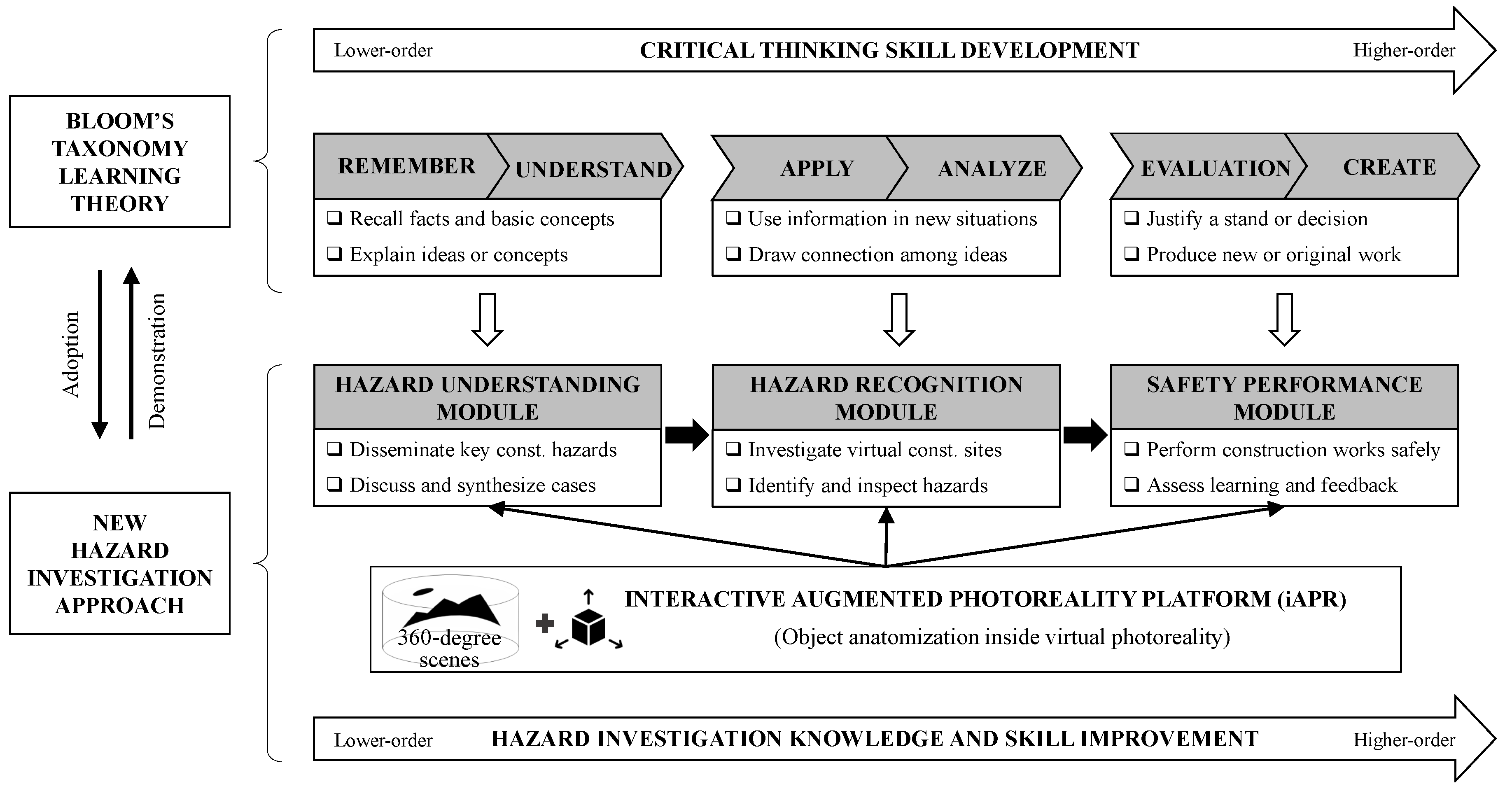

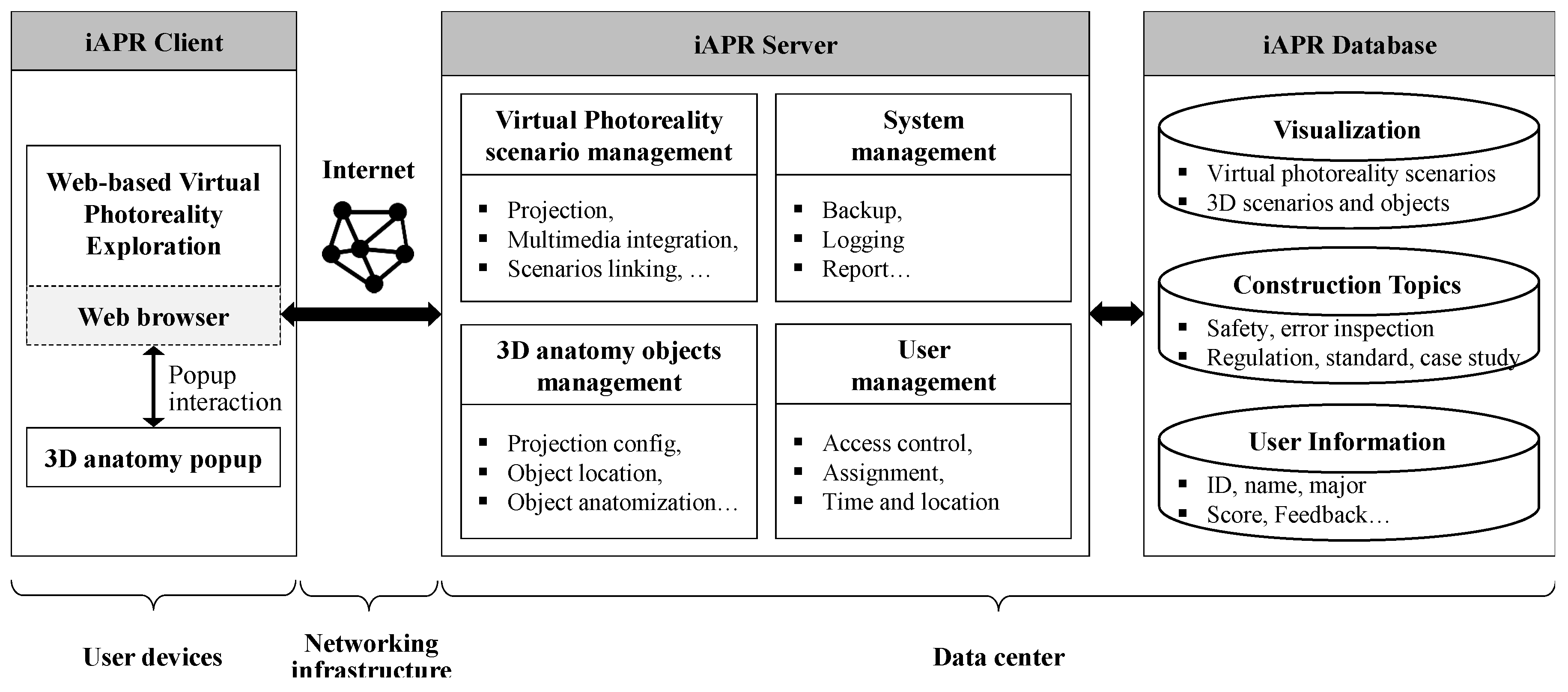
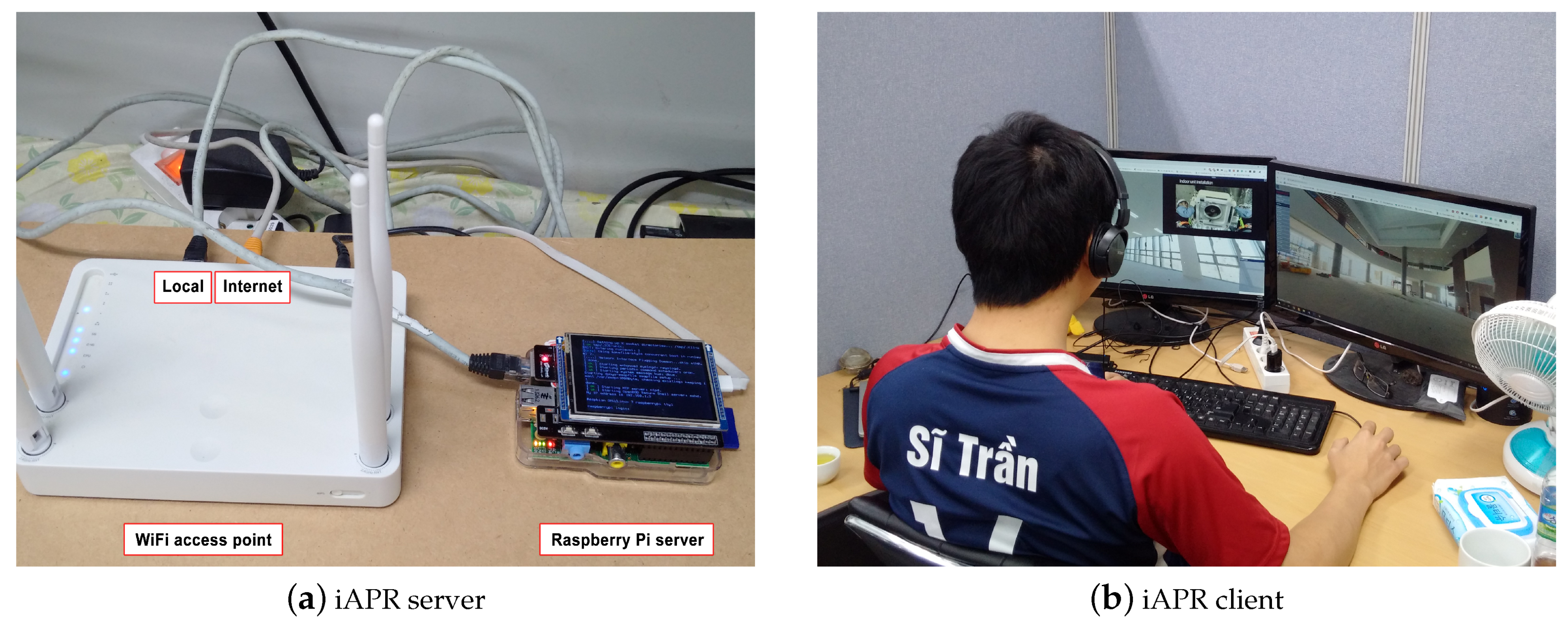
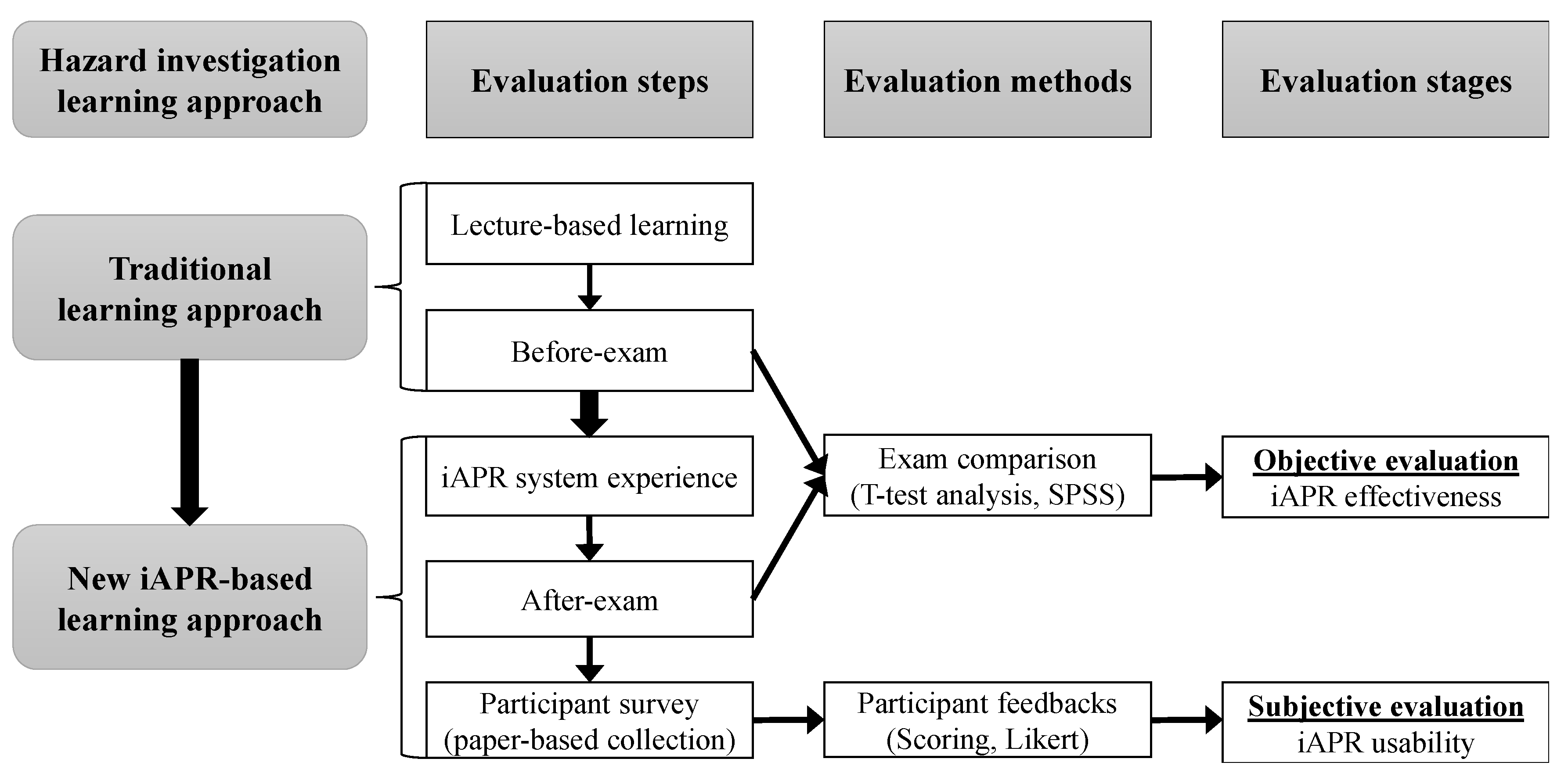
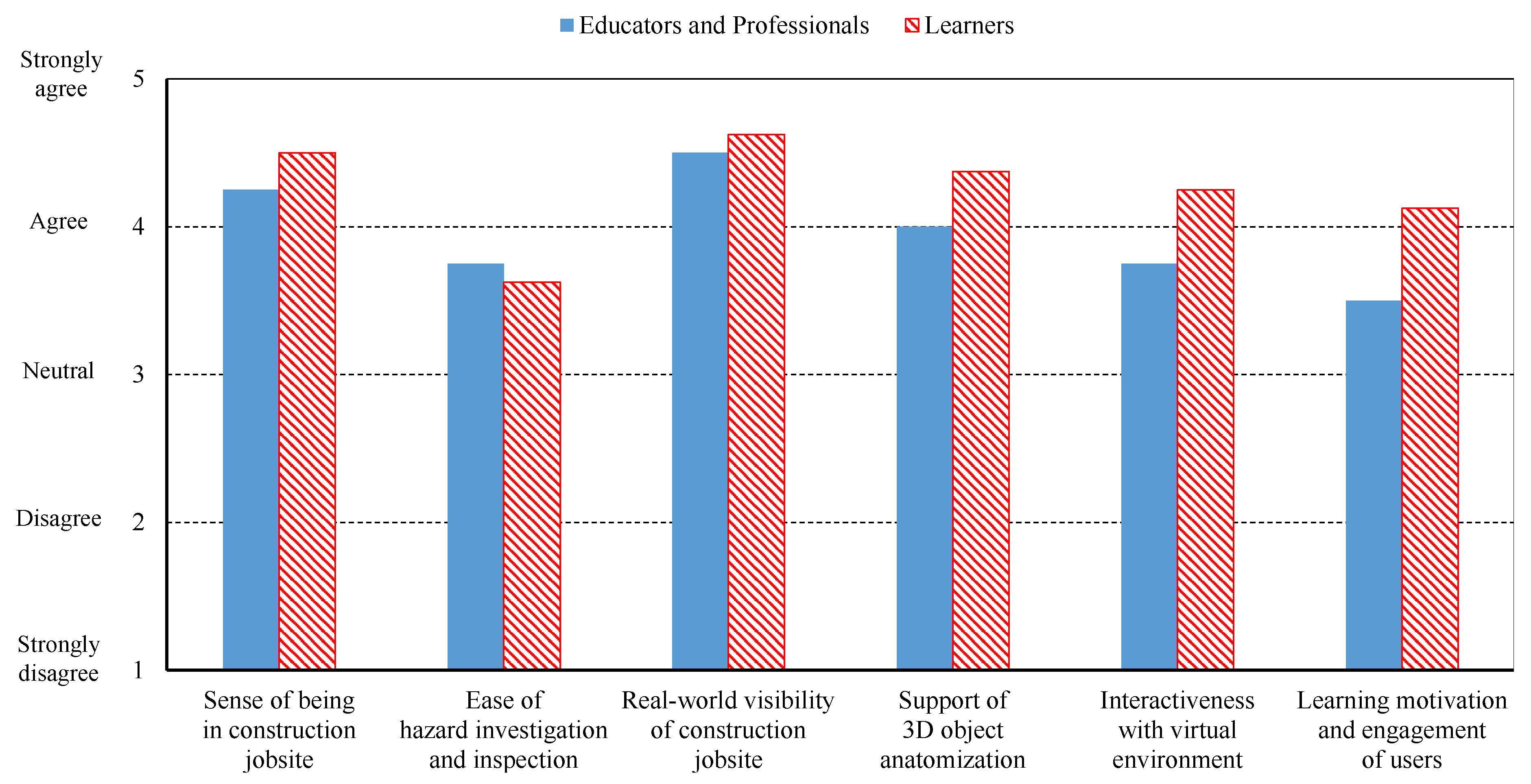
| iAPR Server | iAPR Client | |
|---|---|---|
| Hardware | Raspberry Pi Model B | Laptops and PCs |
| OS | Linux | Windows |
| Software | Krpano (application) & mySQL (database) | Bult-in web browser & NGRAIN software |
| Network | Ethernet link | Ethernet/WiFi access |
| No. | Fatal Four | Potential Hazards | Virtual Scenario |
|---|---|---|---|
| 1 | Falls | Fall from mobile scaffold | 1st floor |
| 2 | Falls | Fall from 2nd floor to ground floor due to lack of guardrails | 2nd floor |
| 3 | Falls | Falling from temporary ladder during installation of ceiling panels | 3rd floor |
| 4 | Falls | Fall from stair due to lack of temporary handrails at the edge of floor | 5th floor |
| 5 | Falls | Fall from Boatswain’s chair due to lack of an independent lifeline | 11th floor |
| 6 | Falls | Fall into opening of stair at the 8th floor due to lack of barriers | 8th floor |
| 7 | Struck by object | Struck-by falling object due to lack of safety nets | Roof |
| 8 | Struck by object | Bricks falling from height on worker’s head without safety helmet | 7th floor |
| 9 | Struck by object | Metal pipes falling on worker’s head during lifting operation | 9th floor |
| 10 | Electrocution | Electrocution when installing an air-conditioner | 10th floor |
| 11 | Electrocution | Electrocution when using hand tool | Basement |
| 12 | Caught-in/between | Worker is trapped during lift maintenance | 12th floor |
| 13 | Caught-in/between | Worker is caught between a truck and concrete due to toppling over of precast concrete building unit | Ground floor |
| N | Mean | Standard Deviation | |
|---|---|---|---|
| Before-exam | 40 | 76.250 | 4.770 |
| After-exam | 40 | 80.125 | 4.001 |
| Paired Differences | t | df | Sig. (2-Tailed) | |||||
|---|---|---|---|---|---|---|---|---|
| Mean | Std. Deviation | Std. Error Mean | 95% Confidence Interval of the Difference | |||||
| Lower | Upper | |||||||
| Pair: Before-After exams | −3.87500 | 5.48746 | 0.86764 | −5.62997 | −2.12003 | −4.466 | 39 | 0.000 |
© 2019 by the authors. Licensee MDPI, Basel, Switzerland. This article is an open access article distributed under the terms and conditions of the Creative Commons Attribution (CC BY) license (http://creativecommons.org/licenses/by/4.0/).
Share and Cite
Pham, H.C.; Dao, N.-N.; Cho, S.; Nguyen, P.T.; Pham-Hang, A.-T. Construction Hazard Investigation Leveraging Object Anatomization on an Augmented Photoreality Platform. Appl. Sci. 2019, 9, 4477. https://doi.org/10.3390/app9214477
Pham HC, Dao N-N, Cho S, Nguyen PT, Pham-Hang A-T. Construction Hazard Investigation Leveraging Object Anatomization on an Augmented Photoreality Platform. Applied Sciences. 2019; 9(21):4477. https://doi.org/10.3390/app9214477
Chicago/Turabian StylePham, Hai Chien, Nhu-Ngoc Dao, Sungrae Cho, Phong Thanh Nguyen, and Anh-Tuan Pham-Hang. 2019. "Construction Hazard Investigation Leveraging Object Anatomization on an Augmented Photoreality Platform" Applied Sciences 9, no. 21: 4477. https://doi.org/10.3390/app9214477
APA StylePham, H. C., Dao, N.-N., Cho, S., Nguyen, P. T., & Pham-Hang, A.-T. (2019). Construction Hazard Investigation Leveraging Object Anatomization on an Augmented Photoreality Platform. Applied Sciences, 9(21), 4477. https://doi.org/10.3390/app9214477







